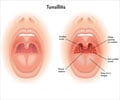In a much-needed article, multidisciplinary clinical practice guideline, Tonsillectomy in Children will be published in the January issue of Otolaryngology—Head and Neck Surgery.

Tonsillectomy is one of the most common surgical procedures in the United States, with over 530,000 procedures performed annually in children under 15 years old. Tonsillectomy is defined as a surgical procedure (performed with or without adenoidectomy) that completely removes the tonsil, including its capsule, by dissecting the peritonsillar space between the tonsil capsule and the muscular wall. Depending on the context in which it is used, the term may indicate tonsillectomy with adenoidectomy, especially in relation to sleep-disordered breathing.
"Over half a million tonsillectomies are done every year in the United States," said Richard M. Rosenfeld, MD, MPH, journal guideline author and consultant. "The tonsillectomy guideline will empower doctors and parents to make the best decisions, resulting in safer surgery and improved quality of life for children who suffer from large or infected tonsils."
The primary purpose of this guideline is to provide clinicians with evidence-based guidance in identifying children who are the best candidates for tonsillectomy. Secondary objectives are to optimize the perioperative management of children undergoing tonsillectomy; emphasize the need for evaluation and intervention in special populations; improve counseling and education for families of who are considering tonsillectomy for their child; highlight the management options for patients with modifying factors; and to reduce inappropriate or unnecessary variations in care.
Source-Eurekalert









